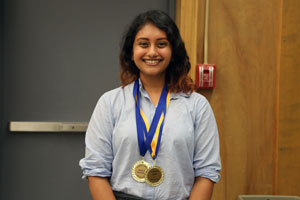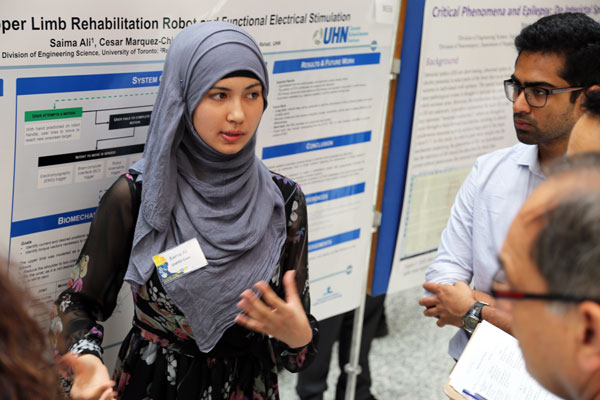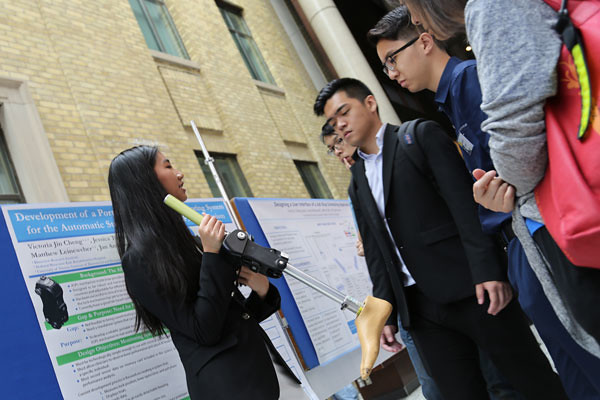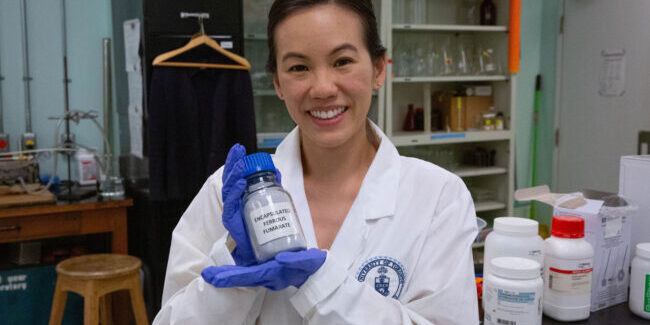On August 9, nearly 100 undergraduate students from across the Faculty presented the results of their summer research at the annual Undergraduate Engineering Research Day (UnERD). Their projects, supervised by professors across U of T Engineering and industry partners, showcased innovations in sustainable energy, new assistive devices, next-generation materials and more.
The day began with a keynote talk from Professor Ted Sargent (ECE) who described his group’s research on new ways to capture and store energy from sunlight. He advised students not to shy away from difficult challenges that are currently unsolved. “If you want to publish in journals like Nature and Science, you need to work on things that don’t work yet,” he said.
For many students, UnERD was their first chance to present their work in a scientific forum and to hear feedback from experienced judges. The top two presenters of the day received the opportunity to publish their research in STEM Fellowship Journal, a not-for-profit, peer-reviewed publication dedicated to showcasing the work of students at the secondary and undergraduate levels.
See more photos from UnERD 2016 in the gallery below.
The top students from the day were:
Jasmine Quigley (Year 4 EngSci) — First Prize

Quigley is spending the summer testing “bioinks,” biocompatible polymers that could be used to 3D-print scaffolds for lab-grown human tissues. One type of polymer will act as a support scaffold for liver, heart, lung or other types of cells, while another will be used fashion blood vessels. By changing the temperature of the system, the second polymer can be melted away, leaving a channel through which nutrients can be delivered and waste products released, just like the blood vessels in real human tissues. Working in the lab of Professor Craig Simmons (MIE, IBBME) Quigley has worked with materials including fibrinogen, hyaluronic acid and gelatin to determine which ones best meet the goals of physical strength, high print resolution and biocompatibility.
Chris Zhang (Medical Biophysics) — Second Prize

Zhang conducted his research in the lab of Professor Gang Zheng (IBBME), working on new chemical constructs that act as contrast agents for magnetic resonance imaging (MRI) scans. MRI scans are an important method for diagnosing cancer and determining the effectiveness of treatment options. Contrast agents help by travelling to specific sites within the body, such as a cancer tumour, and making those areas appear brighter on the scan. Zhang’s constructs are made of both organic and inorganic chemicals, such as manganese, and his research showed that they are stable and non-toxic to cells grown in the lab. The next step is to demonstrate that his contrast agents preferentially migrate to tumour sites. If successful, the work could help identify cancer earlier, when the chances of successful treatment are best.
Onasvi Kharsikar (Year 3 ChemE) — Third Prize
 Kharsikar is co-supervised by Professor Stewart Aitchison (ECE) and Professor Grant Allen (ChemE). She is looking at systems to efficiently grow large quantities of microalgae, microscopic water-borne organisms that could be used as food supplements or even converted into fuel. For her summer project, she used a system known as a parallel plate airlift reactor, in which algae grow on the surface of submerged plates and light is delivered by light-emitting diodes (LEDs). By experimenting with different frequencies of white light — think of a prism splitting light into many colours — as well as the effect of pulsing the lights on and off, she was able to determine which conditions optimized the growth of the microalgae.
Kharsikar is co-supervised by Professor Stewart Aitchison (ECE) and Professor Grant Allen (ChemE). She is looking at systems to efficiently grow large quantities of microalgae, microscopic water-borne organisms that could be used as food supplements or even converted into fuel. For her summer project, she used a system known as a parallel plate airlift reactor, in which algae grow on the surface of submerged plates and light is delivered by light-emitting diodes (LEDs). By experimenting with different frequencies of white light — think of a prism splitting light into many colours — as well as the effect of pulsing the lights on and off, she was able to determine which conditions optimized the growth of the microalgae.





